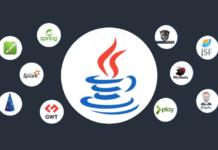
In the ever-evolving landscape of web development, one name consistently stands out: React. So, what exactly is React, and why is it such a game-changer in the world of web applications? At its core, it is used for building user interfaces in web applications. Developed and maintained by Facebook, this powerful JavaScript library provides developers with the tools to create interactive and dynamic user experiences with speed and efficiency.
It isn’t just another framework or technology in a sea of options. Instead, it’s a groundbreaking library that has shifted paradigms, transforming the way companies and developers approach web application development. Its component-based architecture allows developers to build reusable UI components, leading to cleaner code and faster development cycles.
Moreover, with its focus on providing the best user experience possible, React ensures that apps are not only functional but also highly responsive and intuitive. When a company, whether a tech giant like Facebook or a budding startup, decides to use it, they’re not just adopting a tool; they’re investing in an advanced platform that offers significant advantages on the web development arena.
In a nutshell, React is the backbone of countless modern web applications, shaping the way we interact with technology on a daily basis. As we delve deeper into the topic, we’ll uncover the full spectrum of what it is used for and why it remains a top choice for developers globally.

Benefits of Using React.js
React.js, ever since its inception, has become the darling of many developers and React.js development agencies. But what makes this library so special? Let’s delve into the tangible advantages of using React:
- Speed and efficiency. One of the primary reasons developers gravitate towards React is its component-based structure. This architecture allows for the reuse of code components across different parts of an application, leading to quicker development cycles and efficient code management.
- SEO-friendly. In the competitive digital realm, search engine optimization (SEO) is crucial. It improves the performance of applications, and with its ability to run on the server, it allows web crawlers to index apps more effectively, giving a potential SEO boost.
- Productivity enhancements. With its virtual DOM (Document Object Model) implementation, it ensures that only the components that experience changes are re-rendered. This leads to quicker updates and boosts the overall productivity of developers by reducing wait times.
- Rich user experience. Its commitment to providing a seamless user experience is unparalleled. Through its advanced features and technology, developers can build intuitive and dynamic user interfaces, enhancing user satisfaction and engagement.
- Community and ecosystem. Being backed by Facebook, React enjoys the support of a massive community. This provides developers with a wealth of resources, from libraries to tools, ensuring they have everything they need to build top-tier apps.
- Flexibility. Unlike full-fledged frameworks, React is a library. This means developers have the flexibility to integrate React with other libraries or frameworks, tailoring their development environment to their specific needs.
- Stable code. React’s data binding ensures that parent data will not be affected by child component changes, leading to more stable and reliable applications.

What Is React.js Used For?
It has come a long way since its inception, solidifying its position as one of the most sought-after libraries in the domain of web development. Its versatility and robust features have led many industry giants to adopt it for their platforms. Let’s explore some renowned apps and websites that leverage React and the advantages they’ve derived:
- Facebook. As the birthplace of React, it’s no surprise that Facebook utilizes this library extensively. With it, Facebook has been able to deliver a seamless, real-time user experience, handling billions of users and their interactions effectively.
- Instagram. Acquired by Facebook, Instagram’s transition to React has enhanced its performance, offering users a smoother experience while scrolling through endless photos, stories, and reels.
- Dropbox. A leader in cloud storage, Dropbox employs it to ensure a consistent and intuitive user experience across devices. Its component-based architecture has empowered Dropbox to maintain a streamlined UI, facilitating effortless file storage and sharing.
- Discord. This popular communication platform for gamers and communities is built using React. By leveraging its capabilities, Discord offers real-time chat experiences, smooth transitions, and a responsive interface that caters to millions of users simultaneously.
- WhatsApp Web. The web version of the world’s most popular messaging app runs on React. This has enabled a swift and synchronized experience, mirroring the mobile app’s features and performance on web browsers.
- Airbnb. The global travel community platform utilizes it to provide users with a dynamic and interactive experience. From browsing properties to making reservations, its advantages have significantly elevated the platform’s responsiveness and user engagement.
- Netflix. As a streaming behemoth, Netflix requires a high-performance interface to cater to its vast user base. With React, Netflix ensures quick load times, personalized user interfaces, and an optimized viewing experience across various devices.

What these platforms have in common is their quest for excellence in user experience, performance, and scalability. By integrating React into their development ecosystem, they’ve harnessed the library’s advantages, from speed to flexibility. This is testament to the fact that when it comes to building dynamic web applications, it is a preferred choice for both startups and tech titans alike.
Conclusion
In the realm of web development, technologies come and go, ebbing and flowing with the changing tides of innovation. Yet, amidst this dynamic landscape, React.js stands tall as an enduring testament to excellence in design, user experience, and performance.
What’s striking about React isn’t just its technological prowess but its universality. From small startups to global giants like Facebook and Netflix, organizations of all sizes have tapped into the transformative potential of React. They’ve recognized its promise, not just as a tool but as a paradigm shift, reshaping how developers think about and build web applications.
The examples of Dropbox, Discord, and countless others emphasize its flexibility and adaptability. These platforms, each with its own set of unique challenges and requirements, found in React a reliable partner to navigate the intricate maze of web development. It’s a testament to how this library, birthed in the corridors of Facebook, has become the linchpin of a diverse array of web applications.
React’s growth is more than just a trend; it’s a reflection of its undeniable advantages. The speed, the seamless user experience, the component-based architecture, and the supportive community have all coalesced to make React a premier choice for developers.
In wrapping up, if there’s a single takeaway from our exploration, it’s this: React.js is used for building the future of web applications. As we move forward, it will undoubtedly continue to shape, influence, and drive the evolution of the digital world, marking its legacy as a groundbreaking library in web development.











